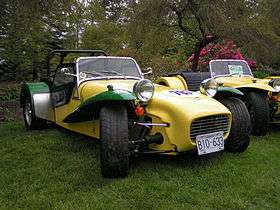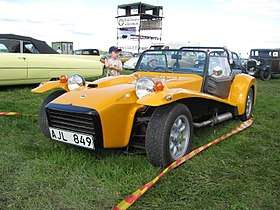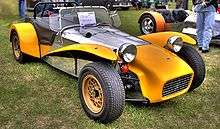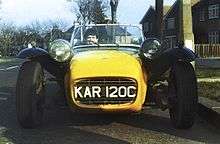Lotus Seven
The Lotus Seven is a small, simple, lightweight two-seater open-top sports car produced by the British manufacturer Lotus Cars (initially called Lotus Engineering)[2] between 1957 and 1972.
| Lotus Seven | |
|---|---|
 | |
| Overview | |
| Manufacturer | Lotus Cars |
| Also called | Lotus 7 Lotus Super Seven [1] |
| Production | 1957–1973 |
| Assembly | Hornsey, London Cheshunt, Hertfordshire Hethel, Norfolk, United Kingdom Martínez, Argentina |
| Designer | Colin Chapman |
| Body and chassis | |
| Class | Sports car |
| Body style | roadster |
| Layout | FMR layout |
| Powertrain | |
| Transmission | manual |
| Chronology | |
| Predecessor | Lotus Mark VI |
| Successor | Caterham 7 |
It was designed by Lotus founder Colin Chapman and has been considered the embodiment of the Lotus philosophy of performance through low weight and simplicity. The original model was highly successful with more than 2,500 cars sold,[3] due to its attraction as a road legal car that could be used for clubman racing.[4]
After Lotus ended production of the Seven, Caterham bought the rights and today Caterham make both kits and fully assembled cars based on the original design known as the Caterham 7.
The Lotus Seven design has spawned a host of imitations on the kit car market, generally called Sevens or sevenesque roadsters.
History
| First generation | |
|---|---|
| Overview | |
| Production | 1957–1960 |
| Body and chassis | |
| Related | Lotus Eleven |
| Powertrain | |
| Engine | 1,172 cc (1.2 L) I4 |
| Second generation | |
|---|---|
.jpg) | |
| Overview | |
| Production | 1961–1967 |
| Powertrain | |
| Engine | 1,340 cc (1.3 L) I4 |
| Third generation | |
|---|---|
.jpg) | |
| Overview | |
| Production | 1968–1969 |
| Powertrain | |
| Engine | 1,600 cc (1.6 L) I4 |
| Fourth generation | |
|---|---|
 | |
| Overview | |
| Production | 1970–August 1973 |
| Powertrain | |
| Engine | 1,600 cc (1.6 L) I4 1,700 cc (103.7 cu in) I4 |

The Lotus Seven was launched in 1957 to replace the Mark VI as the 'entry level' Lotus model, The Seven name was left over from a model that was abandoned by Lotus, which would have been a Riley-engined single-seater that Lotus intended to enter into the Formula Two in 1952 or 1953. However, the car was completed around Chapman's chassis as a sports car by its backers and christened the Clairmonte Special.
Externally similar to Chapman's earlier Lotus Mark VI, but with a different tubular frame similar to the Lotus Eleven, the Seven was powered by a 40 bhp (30 kW; 41 PS) Ford Side-valve 1,172 cc inline-four engine. It was used both on the road and for club racing (750 motor club in the UK).
The Lotus Seven S2 followed in 1960 and was supplemented by the Lotus Super Seven S2 from 1961.[5] The Super Seven initially used the larger Cosworth modified 1,340cc Ford Classic engine and later examples were fitted with 1,498cc or 1,599cc engines.[5] The Seven S3 was released in 1968.[5] In 1970, Lotus radically changed the shape of the car to create the slightly more conventional sized Series 4 (S4), with a squarer fibreglass shell replacing most of the aluminium bodywork. It also offered some luxuries as standard, such as an internal heater matrix.
Between 1970 and 1975, following a representation agreement, Lotus Argentina SA obtained the licence to manufacture the Lotus Seven in Argentina. This production reached approximately 51 units. These vehicles were not replicas, but built under licence and original brand Lotus.[6][7]
Under the Purchase Tax system of the time cars supplied as a kit did not attract the tax surcharge that would apply if sold in assembled form. Tax rules specified assembly instructions could not be included. However, once the UK joined the EEC on 1 January 1973, the VAT system was adopted instead so the tax advantage of the kit-built Lotus Seven came to an end.
In 1973, Lotus decided to shed fully its "British tax system"-inspired kit car image. As part of this plan, it sold the rights to the Seven to its only remaining agents Caterham Cars in England and Steel Brothers Limited in New Zealand.
Caterham ran out of the Lotus Series 4 kits in the early 1970s. When this occurred and in accordance with their agreement with Lotus, Caterham introduced its own brand version of the Series 3. They have been manufacturing the car ever since as the Caterham Seven. Steel Brothers Limited in Christchurch, New Zealand, assembled Lotus Seven Series 4s until March 1979 when the last of the 95 kits provided by Lotus was used up.[8][9] Steel Brothers had a much wider range of factory options than the UK models with carpet, centre console glove-box, radio, window-washer and hard top. Sold largely to competition enthusiasts, the NZ cars also had engine modifications, close-ratio gears and adjustable suspension as factory options. As such they were very successful in local racing. With officially licensed production stopping in 1979, the last Lotus badged Seven, a Series 4, was therefore produced in New Zealand.[10]
Steel Brothers Limited attempted to make a wider, modernised version of the Series 4, the Lotus Super 907, using the twin cam Lotus 907 engine. In the spring of 1978 it was announced that this was to be sold in the United States[11] - but the American importer had no funds and the project came to naught.[12] The single finished Super 907 was moved from the New Zealand to the United States in 2010 to undergo a full restoration.[13]
Analysis of the Seven's performance
Road test
A car with a tuned Ford 1172 cc engine and close ratio gearbox was tested by the British magazine The Motor in 1958. It was found to have a top speed of 80.4 mph (129.4 km/h), could accelerate from 0-60 mph (97 km/h) in 6.2 seconds and had a fuel consumption of 31.0 miles per imperial gallon (9.1 L/100 km; 25.8 mpg‑US). The test car cost £1,157 including taxes of £386. They commented that car could be bought in component form and then it would have cost £399 for the parts from Lotus, £100 for the Ford engine and gearbox and £27 for the BMC rear axle.[14]
Top speed
A Seven's top speed greatly depends upon the body configuration, engine power and gearing. Early models with low-powered engines had difficulty exceeding 90 mph (140 km/h), although a race-prepared Seven was clocked at 127 mph (204 km/h) whilst driven by Brausch Niemann through a speed-trap at the 1962 Natal Grand Prix.[15] In addition, clamshell style wings tend to create drag and generate lift at higher speeds. Cycle wings help alleviate this tendency, and low height Brookland aeroscreens or the lighter Perspex variants that can replace the windscreen help improve top end speed. Sevens do suffer from front end lift at high speed — the nose creates more lift than downforce at speeds over around 70 mph (110 km/h), although retro fitted "winglets" may counter this.
Low speed acceleration
Nearly all Sevens, due to their extremely light weight (around 10cwt / 500 kg) have excellent acceleration, especially up to 70 mph (110 km/h), depending on power. For their time, the original late 1950s Sevens could beat most contemporary saloon cars—and by the early 1960s, with improved Ford-Cosworth engines could take on most high performance sports cars with 0–60 mph time in the low 7 seconds.
Braking
The less powerful early models had drum brakes all round, in common with most road cars of the time. Later models had front disc brakes.
Physics favours small cars in braking and Sevens have excellent stopping distances, but one of the effects of light weight and powerful (non ABS) brakes is the tendency to lock up, especially at the front under strong braking.
Handling
The highest part of the car is about three feet (900 mm) from the road and it has a cloth top and side curtains with plastic back and side windows. The supports for the top and the windshield frame are aluminium. The lower chassis tubes are five inches (127 mm) from the road, while the wet sump, bell housing and one chassis tube are lower, meaning the centre of gravity is very low.
The front/rear weight distribution is nearly equal and the lack of a boot and small petrol tank assure that it remains fairly constant. It is, however, more front-heavy than more modern high performance cars.
Suspension
In the original Seven, the front lower A-arm (or "wishbone") of the double wishbone suspension is traditional, but for the purpose of reducing weight, the upper suspension integrated an anti-roll (anti-sway) bar into a horizontal suspension arm. This approach formed a pseudo-wishbone which was semi-independent in nature. This approach worked well with early crossply tyres, but with later radials, the configuration seriously affected its adjustability.
For the rear suspension, Lotus originally used a live axle (or solid axle). This approach was very cost effective, since most production saloon cars up to the 1980s used these components. A mixture of Ford and Austin components were used. One disadvantage of live axles is higher unsprung weight, affecting handling and ride on rough surfaces.
Aerodynamics
In general, cars with non-optimised aerodynamics tend to be free of adverse aerodynamic effects on handling, but the front wheel arches, of all but the Series I, cause lift at high speeds. Like the good straight line performance, the car's nimble handling is limited in speed range, and this is not usually important in a car intended for public roads.
While the car's frontal area is small, the Lotus Seven has a drag coefficient () among the highest of any known production car - ranging from 0.65 to 0.75, depending on bodywork.
Additionally, the clamshell front wings develop lift. This is accentuated by the slight natural lift caused by rotating wheels. Consequently, Sevens have exhibited understeer at high speeds.
Steering
The rack and pinion steering provides a minimum of play and friction. The light weight assures light steering without power assistance, even with very large tyres. The ratio is quick.
Rigidity of the frame
Like racing cars of the time and the equally respected and more expensive Mercedes-Benz 300SL coupe, it had a multi-tube space frame with high sides to allow a stiffer frame (longer lever arm). However, the Series II and other road versions had simpler frames than the more race oriented Series I.
It is a stressed skin[16] construction, in which the flat aluminium body panels, and especially the floor, stiffen and effectively triangulate the largely rectangular steel tubular frame structure. This gives a rigid frame with few tubes and very little body weight that does not contribute to the frame stiffness. The flat panels avoid difficulties in shaping aluminum sheet into smooth compound curves. On the down side, it does not allow attractive curves or streamlining.
Mechanical details
Engines
The Series 1 seven usually used the English Ford sidevalve (L head or flathead) engine with 49 hp (37 kW), although both BMC series A and FWA s.o.h.c. Coventry Climax engines could be fitted. The series 2 typically used Ford Kent engines of 1,340 cc or 1,500 cc. These were often Cosworth modified; the Cosworth 1,340 cc "Super Seven" delivered 85 bhp (63 kW; 86 PS) and the 1,500 cc "Super Seven 1500" 105 bhp (78 kW; 106 PS). Some late S2 and most S3 sevens were fitted with the later crossflow Kent engine of 1,599 cc; a limited number of cars used the Lotus twin cam engine. The S4 seven could be supplied with 1298 or 1599 cc Kent engines or the twin cam.
Frame and body
The Lotus Seven was designed with racing in mind, and lightness was of primary concern to Chapman. A front-mounted engine driving the rear wheels (a similar layout to most cars of the day) and a very lightweight steel spaceframe was covered with unstressed aluminium panel bodywork. The body panels were mainly flat to avoid the expense of more elaborate curved bodywork, and the simple cloth lined plastic doors were hinged from the windscreen. The nose-cone and wheel arches were originally aluminium parts, but these were replaced in the later S2 and S3 models with painted or self-coloured fibreglass.
Weight
Early Lotus Sevens weighed around 1,100 lb (10cwt/500 kg). Although the weight crept upward as production progressed, it remained remarkably low for a production car of over a litre displacement.
Suspension
The front was by "A" arms and coil springs with an anti-roll bar serving as the front half of the top A arm. The rear had trailing arms, a triangular centre locating member and solid rear axle.
The geometry and high (relative to total) unsprung weight gave it some bump steer, which owners sometimes treated by moving the supports forward and lengthening the trailing arms.
A model that was sold in the US had independent rear suspension and a Coventry Climax engine.
Problem areas
The series II had problems with its Standard Companion estate car rear axle and differential. This was later solved on the Series III with a Ford Cortina rear end.
The tubular spaceframe chassis suffered from rust, especially from the inside which would lead to its sudden and unexpected collapse.
Lotus Seven in the media

- An S2 Lotus Seven (registration plate "KAR 120C"), driven by creator/director & actor Patrick McGoohan, was featured in the opening titles of the 1967–1968 television series The Prisoner - although the car in the final episode, "Fall Out", was another; driven by Caterham Car's MD Graham Nearn.[17]
- Marvel Comics superhero Wolverine drives a Lotus Seven.
- A Lotus Seven appears as one of the steal-able cars in Grand Theft Auto: London 1969, under the name "Locust". Ironically enough there is a replica of the Lotus Seven made under the same name and another version made under the trade name of the Locost.
- In the second game of Sonic Drift series, Tails uses a car called the "Whirlwind S7", which is a reference to the Lotus S7.
- In the game Rage Racer the Age Pegase (top notch handling) is a reference to the Lotus S7
- A Super Seven is driven by the character Sena Wakabayashi in the anime series You're Under Arrest.
- Sōichi Sugano from the anime éX-Driver drives a Super Seven. This series contains several Lotus models, but the Seven is most prominent.
- Jim Skylark from the anime Gate Keepers drives a Super Seven with license plate AEGIS 02. In the series he debuted in the car, outrunning Shun Ukiya's Toyota Sports 800 on the freeway.
- One is featured on the cover of Chris Rea's 1991 album, Auberge. It also appears in the video for the song, Auberge. The car was owned by the guitarist at the time.
Lotus Seven literature
The Lotus Seven has spawned many books, test reports and articles, many of which are still in print.
Lotus Seven 1957-1980
Edited by R.M. Clarke, Brooklands Books, 1980, ISBN 0-907073-13-1, Test reports and articles from magazines around the world.
Lotus Seven Collection No. 1, 1957-1982
Edited by R.M. Clarke, Brooklands Books, 1982, ISBN 0-907073-50-6, Test reports and articles from magazines around the world.
Lotus & Caterham Sevens Gold Portfolio, 1957-1989
Edited by R.M. Clarke, Brooklands Books, 1989, ISBN 1-85520-000-7, Test reports and articles from magazines around the world.
Lotus Seven Gold Portfolio 1957-1973
R.M. Clarke, Brooklands Books, 1996 ISBN 978-1-85520-329-7, Test reports and articles from magazines around the world.
Lotus Caterham Seven Gold Portfolio, 1974-95
edited by R.M. Clarke, Brooklands Books, 1996, ISBN 1-85520-330-8, ISBN 978-1-85520-330-3, Test reports and articles from magazines around the world
The Legend of the Lotus Seven
Dennis Ortenberger, Osprey, 1981, ISBN 0-85045-411-5 (Reissued in 1999 by Mercian manuals.)
Lotus Seven Super Profile
by Graham Arnold, Foulis Motoring Book, Haynes Publishing Group, 1984, ISBN 0-85429-385-X
The Lotus and Caterham Sevens, A Collector's Guide
Jeremy Coulter, Motor Racing Publications Ltd., 1986, ISBN 0-947981-06-3
Lotus Seven: Collector's Guide
by Jeremy Coulter, Motorbooks International, 1994, ISBN 0-947981-71-3, ISBN 978-0-947981-71-6
Lotus Seven: Restoration, Preparation, Maintenance
by Tony Weale, Osprey Automotive, 1991, ISBN 1-85532-153-X
Side Glances, Volumes 1, 2, 3 and 4
by Peter Egan, Brooklands Books and Road & Track, ISBN 1-85520-567-X
Peter Egan's books are collections of his Road & Track column Side Glances many of which feature his Lotus Sevens.
Lotus and Caterham Seven: Racers for the Road
by John Tipler, Crowood Press, 2005, ISBN 1-86126-754-1, ISBN 978-1-86126-754-2
The Magnificent 7: The enthusiasts' guide to all models of Lotus and Caterham Seven
by Chris Rees, Haynes Publishing, Second edition 2007, ISBN 1-84425-410-0 ISBN 978-1844254101
Why build a Seven? Putting a Sportscar on the Road, a personal record.
by Michael Eddenden, 2010, Published by lulu.com, ISBN 978-0-557-54398-4
The building of a Caterham Seven from a Club perspective, it includes much on the owners of Lotus Sevens.
Your Kit Car Assembly Manual
by Gary Brizendine, 2004, published by GNB Motorsports LLC, ISBN 0-9760560-0-3
How to assemble and improve any Lotus Seven or Locost sports car kit.
Replicas
Because of the Seven's relatively simple design, over 160 companies have offered replicas or Seven-type cars over the years.[18] Many have been challenged over the years by the UK rights-holder, Caterham.[19] Such cars are often referred to as "sevenesque"[20] or simply a "seven" or "se7en". Sometimes they are also called clubmans or "locost". Some examples are:
.jpg)
- 527 ShortCut from Russian Federation with Lada engine & parts.
- Almac Clubsprint, by Almac, a kit car manufacturer in New Zealand
- Aries Motorsport Locoblade and Locost in the UK
- Birkin Cars S3, Lotus Seven replica[21]
- BWE Locust, Hornet, Grasshopper
- Caterham owns the rights to reproduce the Lotus Super Seven
- Chinkara Roadster 1.8S
- Cobra Cars produces the Garbí in Spain with the Yamaha R-1 180 hp engine.
- DAX Rush by Dax Cars
- Deman Motorsport
- Elfin Sports Cars, Australian manufacturer of the Elfin Type 3 Clubman and Elfin T5 Clubman.
- ESTfield from RaceTech (using Lada parts)
- Esther
- Fraser Clubman from Fraser Cars Ltd New Zealand
- Great British Sports Cars from UK
- Hauser from Switzerland with BMW engines
- Hispano Aleman from Madrid Spain made the Hispano Alemán Mallorca inspired in the Seven with SEAT engine and parts
- Höckmayr KFZ-Technik (HKT) from Germany also with Audi-Turbo-Engines
- Irmscher 7 from Germany with Opel engines
- Kaipan type 47 and 57. Replica from Czech Republic
- Leitch Super Sprint, Leitch Industries, Invercargill, New Zealand
- Lucalia Clubman, Lucalia Partnerships, Tasmania, Australia; mostly Japanese mechanicals (inline 4)
- Luego Sports Cars Velocity and V8 Viento in UK
- Lynx made in New Zealand between 1985 and 1988
- MAC #1
- Marc Nordon Racing Vortx RT, RT+ and RT Super
- McGregor Motorsport Limited New Zealand Lotus Seven replica kits and manufacturers
- Mitsuoka Zero 1 from Toyama, Japan
- MK Indy from MK Engineering (using Ford Sierra parts)
- Pegasus Automobile from Germany.
- PRB Clubman - manufactured Peter R Bladewell in Strathfield, Sydney Australia.
- Raptor by Tornado Sports Cars
- Several models from Robin Hood Engineering Ltd
- Rotus, originally built with components from Japan in Hagerstown, Maryland. Since founder Chris Custer owned a Toyota dealership, the first cars used a Japanese spec 2litre twin cam Toyota engines and five speed gearbox. Many other engines were used over the years including Mazda rotary up to Rover/Buick V8s.
- Southways Sports Cars SuperCat from Southways Automotive
- Stalker V6 Clubman by Brunton Automotive USA Bradenton, Florida USA
- Superformance S1 Roadster
- Super Martin from France
- Tiger Z100, Tiger R6, Tiger B6, Tiger Avon (like Mel & Jons) & Tiger Cat E1 from Tiger Racing Ltd
- The TSV, a Lotus 7 replica from Greece[22]
- Vindicator Sprint and the four seat Vindicator Family by Vindicator Cars
- Westfield Sportscars produces several models
- Wilco produced in New Zealand between 1992 and 1996.
Also see Category:Lotus Seven replicas
Footnotes
- LA Manwaring, The Observer's Book of Automobiles, Tenth Edition, 1964, page 152
- "Group Lotus History". Archived from the original on 29 August 2006. Retrieved 17 October 2006.
- "Lotus 7 Register". Retrieved 19 October 2006.
- "Classic Clubmans History". Archived from the original on 28 September 2007. Retrieved 19 October 2006.
- Michael Sedgwick & Mark Gillies, A-Z of Cars 1945-1970, page 117
- "The story of the Lotus Sevens manufactured in Argentina", Richard Vignoles (Spanish)
- Steelbro innovations keep it in front of competition, The Press, Christchurch, 14 September 2007, Fairfax Media
- New Zealand Classic Car magazine, Volume 22 Issue 2, page 67, ISSN 1170-9332
- "The last Lotus 7", pg 8, Club Lotus, No. 57
- Webster, Mark (2002), Assembly: New Zealand Car Production 1921-98, Birkenhead, Auckland, New Zealand: Reed, p. 146, ISBN 0-7900-0846-7
- Rosner, Jon (June–July 2003). "Super 907". Chapman Report Online. Golden Gate Lotus Club. Retrieved 15 April 2013.
- http://gglotus.org/blog/?p=1570
- "The Lotus Seven". The Motor. 12 February 1958.
- "Natal Grand Prix". Retrieved 21 October 2006.
- https://www.cnet.navy.mil/nascweb/sas/stress.htm%5B%5D
- Henry, Alan (10 November 2009). "Graham Nearn obituary". Retrieved 21 February 2019.
- Seven Models Archived 28 April 2008 at the Wayback Machine
- ""ReMarque" August 1986, page 1 - Lawsuits Fly as "Sevens" Proliferate" (PDF).
- "Sevenesque builds". Madabout Kitcars. Retrieved 18 December 2011.
- "Home". Birkindirect.com. Retrieved 18 December 2011.
- "Lotus Seven From Greece". Tsv.gr. Retrieved 18 December 2011.
References
- Jeremy Coulter. The Lotus and Caterham Sevens. Croydon: Motor Racing Publications Ltd., 1986. ISBN 0-947981-06-3
- Lotus Super Seven Series II owner's manual, Lotus Components.
- Lotus Seven Register
- Peter Ross "Lotus - The Early Years 1951-54". Coterie Press, 2004. ISBN 1-902351-12-6 describes the original Lotus Mark VII single seater.
External links
| Wikimedia Commons has media related to Lotus Seven. |
- Lotus Seven Register
- http://www.7-dna.com/ Forum for all 7 type vehicles that have some aspect of Lotus 7 DNA running through them.
- https://web.archive.org/web/20130616081519/http://sevener.fr/
- http://www.birkindirect-usa.com/ Birkin Official USA Website